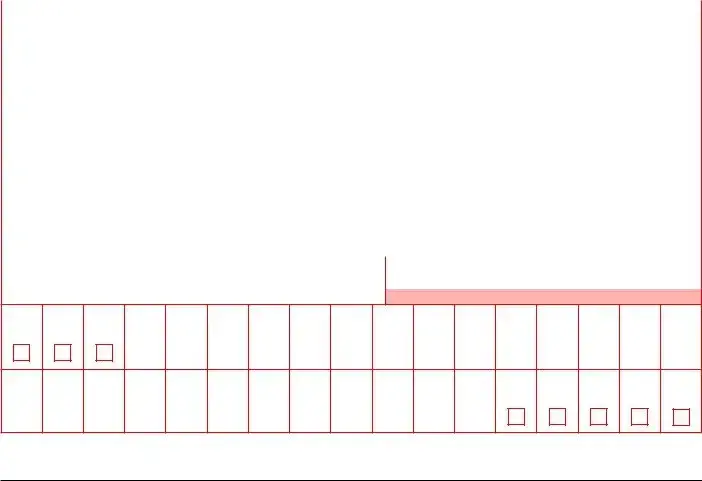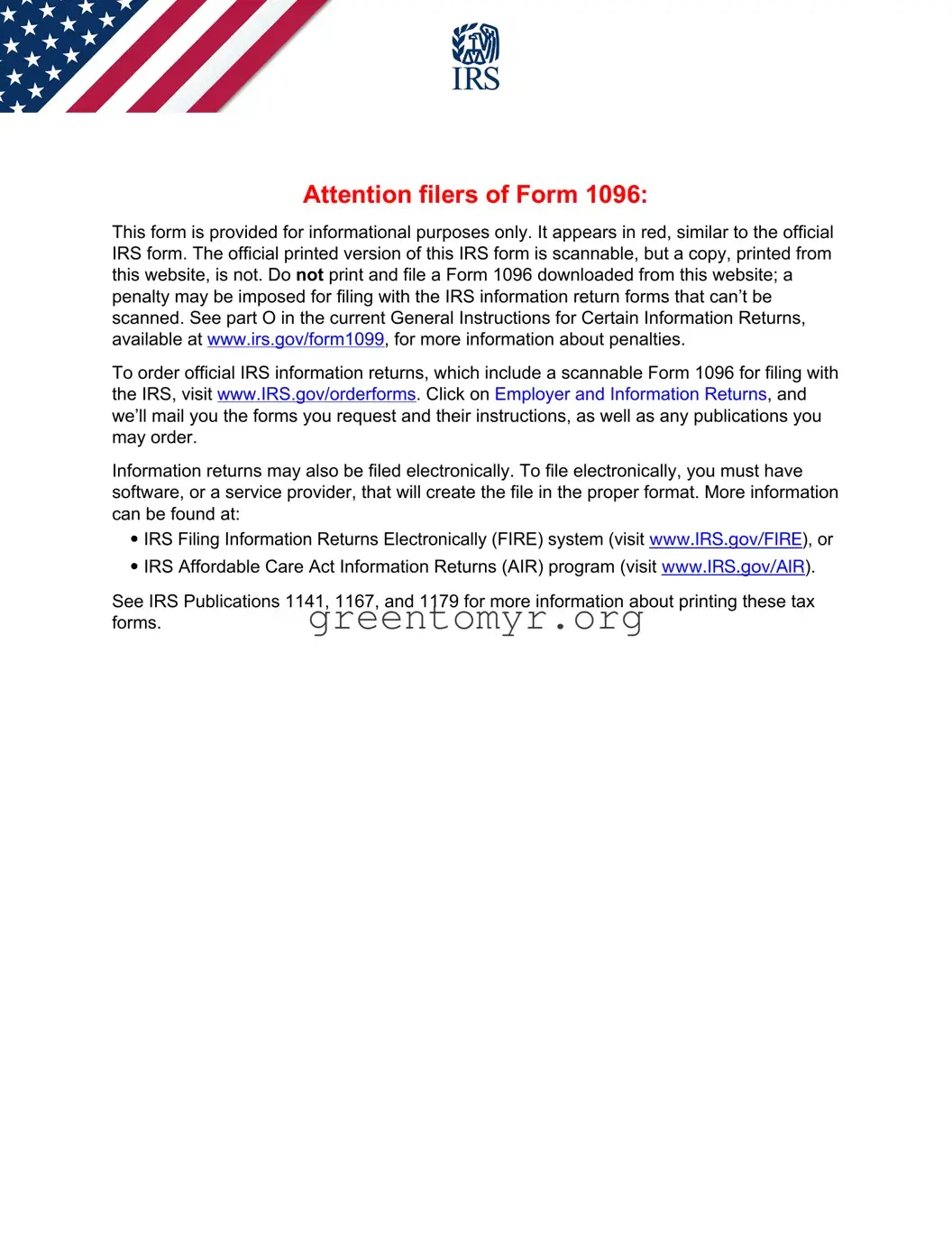Attention filers of Form 1096:
This form is provided for informational purposes only. It appears in red, similar to the official IRS form. The official printed version of this IRS form is scannable, but a copy, printed from this website, is not. Do not print and file a Form 1096 downloaded from this website; a penalty may be imposed for filing with the IRS information return forms that can’t be scanned. See part O in the current General Instructions for Certain Information Returns, available at www.irs.gov/form1099, for more information about penalties.
To order official IRS information returns, which include a scannable Form 1096 for filing with the IRS, visit www.IRS.gov/orderforms. Click on Employer and Information Returns, and we’ll mail you the forms you request and their instructions, as well as any publications you may order.
Information returns may also be filed electronically. To file electronically, you must have software, or a service provider, that will create the file in the proper format. More information can be found at:
•IRS Filing Information Returns Electronically (FIRE) system (visit www.IRS.gov/FIRE), or
•IRS Affordable Care Act Information Returns (AIR) program (visit www.IRS.gov/AIR).
See IRS Publications 1141, 1167, and 1179 for more information about printing these tax forms.

Do Not Staple 6969
Form 1096 |
|
Annual Summary and Transmittal of |
|
|
|
|
|
|
|
|
|
OMB No. 1545-0108 |
|
|
|
|
|
|
|
|
|
|
|
|
|
|
|
|
|
|
|
|
|
|
|
|
|
|
|
|
|
|
|
2021 |
|
|
(Rev. February 2021) |
|
|
U.S. Information Returns |
|
|
|
|
|
|
|
|
|
|
|
Department of the Treasury |
|
|
|
|
|
|
|
|
|
|
|
|
|
Internal Revenue Service |
|
|
|
|
|
|
|
|
|
|
|
|
|
|
|
|
|
|
|
|
|
|
|
|
|
|
|
|
|
|
|
|
|
|
|
|
|
|
|
|
|
|
|
|
|
|
|
|
|
|
|
|
|
|
|
|
|
|
|
|
|
|
|
FILER’S name |
|
|
|
|
|
|
|
|
|
|
|
|
|
|
|
|
|
|
|
|
|
|
|
|
|
|
|
|
|
|
Street address (including room or suite number) |
|
|
|
|
|
|
|
|
|
|
|
|
|
|
|
|
|
|
|
|
|
|
|
|
|
|
|
|
|
City or town, state or province, country, and ZIP or foreign postal code |
|
|
|
|
|
|
|
|
|
|
|
|
|
|
|
|
|
|
|
|
|
|
|
|
|
|
|
|
|
|
|
|
|
|
|
|
|
For Official Use Only |
Name of person to contact |
|
|
Telephone number |
|
|
|
|
|
|
|
|
|
|
|
|
|
|
|
|
|
|
|
|
|
|
|
|
|
|
|
|
|
|
|
|
|
|
|
|
|
|
|
|
|
|
|
|
|
|
|
|
|
|
|
|
|
|
|
|
|
|
|
|
|
|
|
|
|
|
Email address |
|
|
Fax number |
|
|
|
|
|
|
|
|
|
|
|
|
|
|
|
|
|
|
|
|
|
|
|
|
|
|
|
|
|
|
|
|
|
|
|
|
|
|
|
|
|
|
|
|
|
|
|
|
|
|
|
|
|
|
|
|
|
|
|
|
|
|
|
|
|
|
|
|
|
|
|
|
|
|
|
|
|
|
|
|
|
|
|
|
|
|
|
|
|
|
|
1 Employer identification number |
2 Social security number |
|
3 Total number of forms |
4 Federal income tax withheld |
5 Total amount reported with this Form 1096 |
|
|
|
|
|
$ |
|
|
|
|
|
|
$ |
|
|
|
|
|
|
|
|
|
|
|
|
|
|
|
|
|
|
|
6 Enter an “X” in only one box below to indicate the type of form being filed.
W-2G |
1097-BTC |
1098 |
1098-C |
1098-E |
1098-F |
1098-Q |
1098-T |
1099-A |
1099-B |
1099-C |
1099-CAP |
1099-DIV |
1099-G |
1099-INT |
1099-K |
1099-LS |
32 |
|
50 |
|
81 |
|
78 |
|
84 |
|
03 |
|
74 |
|
83 |
|
80 |
|
79 |
|
85 |
|
73 |
|
91 |
|
86 |
|
92 |
|
10 |
|
16 |
|
|
|
|
|
|
|
|
|
|
|
|
|
|
|
|
|
|
|
|
|
|
|
|
|
|
|
|
|
|
|
|
|
|
|
|
|
|
|
|
|
|
|
|
|
|
|
|
|
|
|
|
|
|
|
|
|
|
|
|
|
|
|
|
|
|
|
|
|
|
|
|
|
|
|
|
|
|
|
|
|
|
|
|
|
|
|
|
|
|
|
|
|
|
|
|
|
|
|
|
|
|
|
|
|
|
|
|
|
|
|
|
|
|
|
|
|
|
|
|
|
|
1099-LTC |
1099-MISC |
1099-NEC |
1099-OID |
1099- |
1099-Q |
1099-QA |
1099-R |
1099-S |
1099-SA |
1099-SB |
3921 |
3922 |
5498 |
5498-ESA |
5498-QA |
5498-SA |
93 |
|
95 |
|
71 |
|
96 |
|
PATR |
31 |
|
|
1A |
98 |
|
75 |
|
94 |
|
43 |
|
25 |
|
26 |
|
28 |
|
72 |
|
|
2A |
27 |
|
|
|
|
|
|
|
|
|
|
|
|
|
97 |
|
|
|
|
|
|
|
|
|
|
|
|
|
|
|
|
|
|
|
|
|
|
|
|
|
|
|
|
|
|
|
|
|
|
|
|
|
|
|
|
|
|
|
|
|
|
|
|
|
|
|
|
|
|
|
|
|
|
|
|
|
|
|
|
|
|
|
|
|
|
|
|
|
|
|
|
|
|
|
|
|
|
|
|
|
|
|
|
|
|
|
|
|
|
|
|
|
|
|
|
|
|
|
|
|
|
|
|
|
|
|
|
|
|
|
|
|
|
|
|
|
|
|
|
|
|
|
|
|
|
|
|
|
|
|
|
|
|
|
|
|
|
|
|
|
|
|
|
|
|
|
|
|
|
|
|
|
|
|
|
|
|
|
|
|
|
|
|
|
|
|
|
|
|
|
|
|
|
|
|
|
|
|
|
|
|
|
|
|
|
Return this entire page to the Internal Revenue Service. Photocopies are not acceptable.
Send this form, with the copies of the form checked in box 6, to the IRS in a flat mailer (not folded).
Under penalties of perjury, I declare that I have examined this return and accompanying documents and, to the best of my knowledge and belief, they are true, correct, and complete.
Signature ▶
Instructions
Future developments. For the latest information about developments related to Form 1096, such as legislation enacted after it was published, go to www.irs.gov/Form1096.
Reminder. The only acceptable method of electronically filing information returns listed on this form in box 6 with the IRS is through the FIRE System. See Pub. 1220.
Purpose of form. Use this form to transmit paper Forms 1097, 1098, 1099, 3921, 3922, 5498, and W-2G to the IRS.
Caution: If you are required to file 250 or more information returns of any one type, you must file electronically. If you are required to file electronically but fail to do so, and you do not have an approved waiver, you may be subject to a penalty. The Taxpayer First Act of 2019, enacted July 1, 2019, authorized the Department of the Treasury and the IRS to issue regulations that reduce the 250-return requirement for 2021 tax returns. If those regulations are issued and effective for 2021 tax returns required to be filed in 2022, we will post an article at www.irs.gov/Form1099 explaining the change. Until regulations are issued, however, the number remains at 250, as reflected in these instructions. For more information, see part F in the 2021 General Instructions for Certain Information Returns.
Forms 1099-QA and 5498-QA can be filed on paper only, regardless of the number of returns.
Who must file. Any person or entity who files any of the forms shown in line 6 above must file Form 1096 to transmit those forms to the IRS.
Enter the filer’s name, address (including room, suite, or other unit number), and taxpayer identification number (TIN) in the spaces provided on the form. The name, address, and TIN of the filer on this form must be the same as those you enter in the upper left area of Forms 1097, 1098, 1099, 3921, 3922, 5498, or W-2G.
When to file. File Form 1096 as follows.
•With Forms 1097, 1098, 1099, 3921, 3922, or W-2G, file by February 28, 2022.
•With Forms 1099-NEC, file by January 31, 2022.
•With Forms 5498, file by May 31, 2022.
Where To File
Send all information returns filed on paper with Form 1096 to the following.
If your principal business, office |
Use the following |
or agency, or legal residence in |
the case of an individual, is |
address |
located in |
|
▲ |
▲ |
Alabama, Arizona, Arkansas, Delaware, |
|
Florida, Georgia, Kentucky, Maine, |
Internal Revenue Service |
Massachusetts, Mississippi, New |
Austin Submission Processing Center |
Hampshire, New Jersey, New Mexico, |
P.O. Box 149213 |
New York, North Carolina, Ohio, Texas, |
Austin, TX 78714 |
Vermont, Virginia |
|
For more information and the Privacy Act and Paperwork Reduction Act Notice, |
Cat. No. 14400O |
Form 1096 (2021) |
see the 2021 General Instructions for Certain Information Returns. |
|
|



